How To Grow Cannabis Outdoors: Complete Guide For Beginners
- Is it legal to grow weed outdoors?
- Is growing weed outdoors worth it?
- Basic equipment for growing weed outside
- Stages of growing weed outdoors
- How long does weed take to grow outdoors?
- When to start growing weed outdoors
- Choose the right strain
- Soil for growing weed outdoors
- Nutrients for growing marijuana outdoors
- A couple more tips and tricks
- FAQ
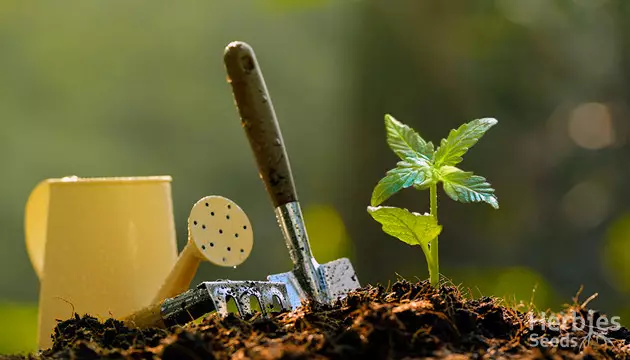
Growing your own cannabis is deeply rewarding – but it can also be demanding. First-time cultivators, especially those with limited resources, may find that growing cannabis indoors or in a greenhouse is far too expensive an investment. That’s where our complete guide to growing cannabis outdoors comes in. By mastering outdoor growing techniques, you can save both time and money – all while producing a rich, satisfying harvest. Embracing the natural environment simplifies the process and maximizes your cannabis yield with minimal investment.
Is It Legal To Grow Weed Outdoors?
The very first thing you want to do before embarking on your growing adventure is get acquainted with your local laws regarding cannabis growing and analyze all the risks. Generally speaking, growing weed outdoors is usually as legal as indoor grow. The legality of this action, however, varies greatly from country to country, and even from state to state if we’re talking about the U.S.
For example, adults can legally grow up to five marijuana plants in Canada, six in the Netherlands, and an unlimited number in South Africa. In the United States, you’re allowed to grow marijuana for recreational use in Alaska, California, Colorado, Maine, Massachusetts, Michigan, Nevada, Oregon, Vermont, and Washington D.C. However, the number of plants allowed for cultivation varies not only depending on the state, but also on whether or not you have a medical prescription for cannabis – which, by the way, can also double the number of plants you’re allowed to grow.
Disclaimer: Cannabis cultivation laws vary by region. This information is intended for use only in areas where growing cannabis is legal. Please check your local laws before proceeding. Consult your medical adviser before use.
Is Outdoor Cannabis Cultivation Worth It?
Growing marijuana outdoors is 100% worth it, as it presents some unbeatable pros that will satisfy any grower. Here they are:
Low Cost
Everything indoor growers pay to replicate – light, humidity, temperature, and airflow – comes free outdoors. Sun, wind, and rain do the heavy lifting, cutting costs dramatically. With the right grow spot, all you’ll need to cover is seeds, pest control, and maybe a bit of extra nutrition.
Larger Yields
Outdoor cannabis isn’t limited by space – roots and branches can grow freely under the full power of the sun. More light means bigger yields, and outdoors, plants can reach their full potential, often producing up to 500g (1.1 lbs) of dry buds or even more.
High-Quality Bud
Buds harvested from outdoor marijuana are exceptionally flavorful – just ask any seasoned grower! If you pick a terpene-rich strain and grow it under warm sun, wind, and rain, you’ll be in for one of the tastiest smoke sessions of your life.
Basic Equipment For Growing Weed Outside: What Do You Need?
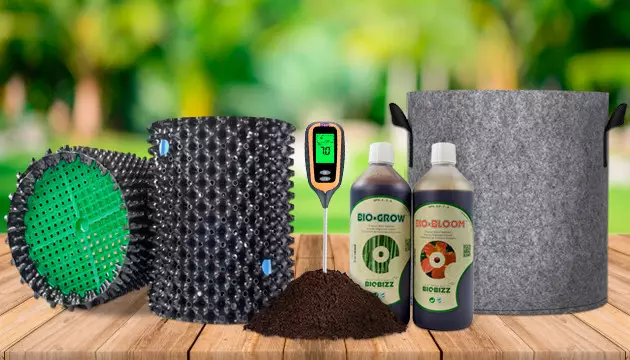
Equipment necessary for developing cannabis is typically split into two primary categories: gear that’s essential, and optional equipment that exists only to help produce higher yields. For instance, the most expensive item commonly utilized by outdoor cannabis cultivators is a greenhouse, although this piece of equipment is optional, not a necessity to begin growing.
Essential growing equipment typically includes:
- Cannabis seeds or clones
- Pots or other types of containers
- Soils and fertilizers
- Pesticides
Stages Of Growing Weed Outdoors
Before we move forward, let’s touch upon the main stages of growing weed outdoors that we’ll describe in more detail later in the article.
- Germination and seedling stage. Cannabis seeds typically begin to germinate when exposed to moisture and a constant temperature of around 65° F (about 18.3° C). Experts suggest keeping your crop indoors from germination up to about 4 weeks of growth before bringing it outside into suitable weather.
- Vegetative stage. When the young plant is strong enough, it’s time to plant it outdoors once the weather becomes warm – normally around May in most areas. While your cannabis is getting used to the outdoors, pay special attention to protecting it from pests and elements. The vegetative stage is also the period for training your cannabis.
- Flowering stage. Autoflowers will start flowering on their own, but photoperiod plants will switch to this stage after receiving less than 12 hours of light a day. At this point, you stop any LST or HST techniques, while the plant mostly stops growing and puts most of its energy into forming buds. If you’re growing weed from regular seeds, the beginning of the flowering stage is also when you sex your plants and cut down the males.
- Harvest. When the bigger fan leaves start to wilt and turn yellow and the trichomes turn from milky to amber, it’s your cannabis telling you it’s time to harvest. It’s important to choose a cannabis strain suitable for your climate – otherwise, you won’t be able to harvest before it gets too cold outside. For your convenience, at Herbies, we always state each seed’s harvest time on its respective page.
How Long Does Weed Take To Grow Outdoors?
Outdoor cannabis grow time depends on the strain. Autoflowers finish in as little as two months, while photoperiod strains take 3–6+ months but grow larger and yield more. The earlier you plant, the longer the veg stage. Most outdoor harvests happen between late September and early October, depending on strain and climate.
When Growing Weed Outdoors, Consider The Climate
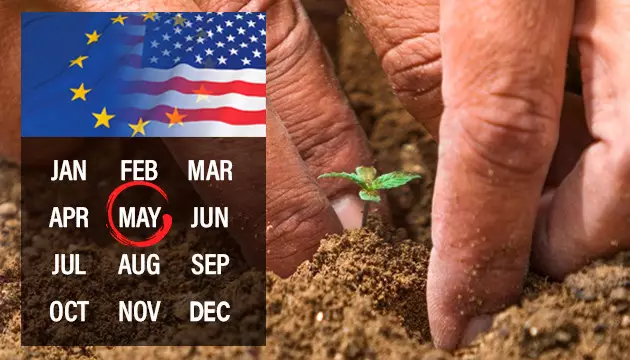
Unlike indoor cultivation practices, which allow for year-round growing, outdoor cultivators are very much at the mercy of mother nature. Growing outdoors requires patience, as there’s a minimal window in which cultivators must germinate seeds, rear them through both the vegetative and flowering stages, and finally, harvest their plants. As mentioned earlier, experts recommend beginning your crops indoors, where they will be safe from potential frost, and then transplanting them outdoors as temperatures start to rise. In just the same way, you need to harvest before the cold weather comes around again.
If you decide to grow outdoors, it’s important to always coordinate your actions with the weather conditions: in case of drought, don’t forget to water plants more frequently; in case of a heatwave, cover your plants with a net; in case of hail, put something over the bush to keep the bud sites intact.
When To Start Growing Weed Outdoors
Outdoor cultivators living in tropical regions have the added advantage of year-round growing, while those living further north must time their grow accordingly. In most areas around Europe and the United States, cultivators can hope to plant outdoors sometime around May. However, thoroughly inspect the recommended sowing times for leafy greens in your region for a better estimate.
Choose The Right Strain
Any cannabis variety is capable of being grown in an outdoor environment, especially when harvested by experienced cultivators under suitable conditions. However, not every strain is capable of yielding equivalent results, as each type is better suited to a specific climate, growing season length, level of humidity, and other growing conditions. If you’re attempting an outdoor grow for the first time, consider getting a feminized or autoflowering cannabis strain to maximize your likelihood of successfully developing a healthy plant resulting in an abundant yield.
Seeds Vs. Clones: What Do I Pick?
You can start your outdoor grow with seeds or clones. Clones produce identical, always-female plants, ensuring consistent buds each harvest. However, they require more care – maintaining a mother plant, hardening off before outdoor planting, and managing weaker root systems.
Seeds, while less uniform, grow stronger and taller, with better resistance to wind and drought. They also tend to yield more. Feminized seeds from reliable breeders offer a stable alternative, combining resilience with consistent results. For most outdoor growers, seeds are the easier, more rewarding choice.
Best Weed Strains For Outdoor Growing
The following strains are ideal for first-time outdoor cultivators, as they each excel in most climates and conditions. However, it’s just a sneak peek – check out our Outdoor Cannabis Seeds Collection for the full selection.
How about a hard-hitting 27% THC Indica in an easy-to-grow autoflowering format? This giggly and euphoric plant grows huge nuggets ready for harvesting in just 70-75 days from seed. This means that if you plant Godzilla Cookies Auto early enough, by the time you harvest, you can plant the next round of bushes and harvest them too before the cold hits – twice as much potent weed in one season!
Looking for a low-maintenance outdoor grow with knockout effects? Northern Lights is a classic Indica-dominant strain with up to a whopping 35% THC that thrives in sunny gardens. It finishes fast and stacks up fat, resinous buds. It’s also highly resistant to pests, mold, and cooler temps – perfect for outdoor growers chasing a chill, couch-lock high without the hassle.
Glue Sherbert thrives under the sun, combining rugged outdoor performance with sky-high potency – up to 30% THC! This Indica-leaning hybrid pumps out sticky, aromatic buds rich in sweet, earthy flavors. With vigorous growth, natural pest resistance, and generous yields, it’s the kind of plant that rewards minimal effort with maximum fire.
Chemdog Fast Version is a powerhouse strain built for speed and strength outdoors. This 65% Indica packs up to 31% THC and finishes flowering in just around 9-10 weeks – early enough to dodge autumn rains with ease. Its dense, resin-coated buds reek of classic diesel and hit hard, while the plant’s mold resistance and sturdy build make it a reliable choice for sun-grown success.
Spotting The Ideal Site For Growing Outdoor Cannabis
Choosing the right location for your outdoor cannabis grow is essential for plant health and a successful harvest. Prioritize a spot with maximum direct sunlight, especially during midday when light is strongest. Good airflow is also crucial, as it strengthens stems, but in very windy areas, use natural windbreaks like fences or hedges to prevent damage. Privacy and security are equally important – protect your grow from thieves or curious neighbors by planting near tall fences, shrubs, or trees. A well-chosen site supports every stage of growth, from germination to harvest, and sets the foundation for a thriving outdoor cannabis garden.
Soil For Growing Weed Outdoors: What You Need To Consider
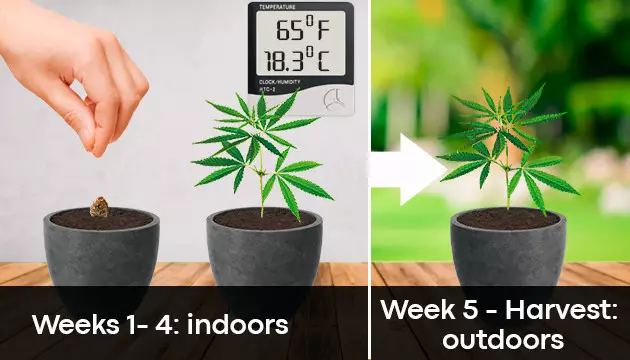
When selecting a good soil, keep in mind that most soils primarily consist of clay, silt, and sand. Your crop requires a slightly acidic soil combined with adequately drained organic matter. Therefore, it’s paramount to thoroughly research various types of soil before planting, especially if planting directly into the earth, to ensure a healthy crop with maximum yield capabilities.
Common types of earth include:
- Clay-rich soil – This heavy soil drains slowly and doesn’t hold oxygen particularly well.
- Sand-rich soil – This drains well and warms quickly. However, it does not hold nutrients as well, giving it the potential to be problematic in wet climates.
- Silt-rich soil – The silt particles are small enough to hold more nutrients than sand and big enough to drain better than clay.
To alleviate the disadvantages of the soil you already have in your backyard, consider growing plants in pots filled with a cannabis-specific soil mix or even supersoil. Well-chosen nutrients and their organic options like manure, compost, or compost tea can also help you utilize the soil you have to the fullest. For the full breakdown of soils for cannabis, read our full article on the topic.
Best Nutrients For Growing Marijuana Outdoors
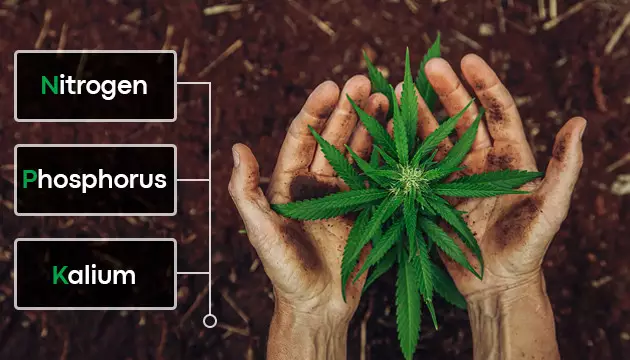
Cannabis plants require generous amounts of nutrients throughout their lifecycle, consisting primarily of phosphorus, potassium, and nitrogen. However, how exactly your crops are fed depends entirely upon the methods utilized and the composition of your soil.
Commercial fertilizers are tailored for home gardeners and come in various types, including long-release granular options. However, first-time cannabis cultivators may want to avoid these unless they fully understand how they work and what their plants need to thrive. Without proper knowledge, these fertilizers can lead to nutrient deficiencies, which may stunt growth and reduce yields.
Then there are liquid fertilizers, which make nutrients readily available for your plants. We recommend using these to minimize the risks of overfeeding, nutrient toxicity, and lockout. Consider beginning with a cannabis-specific fertilizer to supply your harvest with the right nutrients required to grow and thrive outdoors.
One of the best options is using organic options like compost or supersoil. These media are full of beneficial micro-life that constantly produce micro and macronutrients. Hence, they’re self-regulatory, meaning they’ll never cause any issues with nutrients.
Best Pot Size For Growing Marijuana Outdoors
If you don’t have garden space, growing cannabis in pots is a great alternative. Containers can be placed on patios, rooftops, or decks and moved to optimize sunlight or protect plants from wind and heat. However, container size limits root growth, often resulting in smaller plants. Five-gallon pots work well for small to medium plants, while ten-gallon containers suit larger crops. With the right techniques, you can still achieve impressive plant’s growth. Just be sure to prevent root overheating in hot weather, as it can slow development and reduce overall yields.
Water Your Cannabis Plants
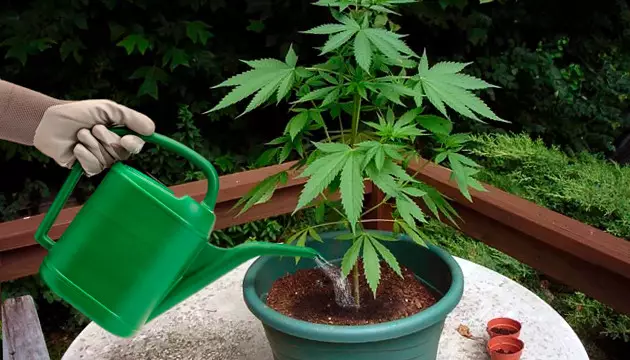
Just like any other plant, your cannabis crops require healthy water consumption. Therefore, an added advantage of outdoor cannabis cultivation practices is continuous exposure to rainwater (although when growing in places such as California, with warmer climates and minimal rainfall, manual watering of plants is often required). However, be sure not to overwater your plants, as this could prove detrimental to their health. If you reside in a hot and dry climate, you may wish to consider digging beneath your chosen grow site and adding clay-rich soil or rocks as a way to help slow water drainage. Some cannabis cultivators believe that adding polymer crystals to your soil likewise helps to improve water retention.
Watch Out For Males And Hermaphrodites
After the beginning of the flowering stage, it’s the perfect time to rid your grow space of both male cannabis plants and hermaphrodites, as these don’t yield tasty buds and generally possess minimal amounts of THC. Moreover, if males and hermaphrodites aren’t removed, they will pollinate your female crops. Once pollinated, females will use their energy to develop seeds instead of focusing on bud development.
So, how do you spot a male cannabis plant or hermaphrodite? Unfortunately, there’s no easy way of telling before your crop enters the flowering phase. Typically, most cannabis strains comprise a 50/50 male to female ratio, so if you notice pollen sacs throughout your plant, remove the plant immediately, or else you run the risk of ruining your entire operation. To learn more about sexing cannabis, read our full article on this matter.
Protect Your Outdoor Cannabis Plants From Pests

Certain dangers such as pests, mold, and powdery mildew could be detrimental to the health and overall wellbeing of your cannabis plant. Fortunately, there are numerous methods commonly employed to help protect your crop.
Applying pesticides is one surefire way to help prevent potential pest invasions. However, many cultivators would rather not deal with these damaging chemicals. Luckily, there are always safer options – for example neem oil. This natural pesticide is 100% safe for your outdoor cannabis plants and active against 400+ types of pest and mold!
Other viable options include techniques such as companion planting, where cannabis is cultivated close to other species of plants – for example, basil and dill – to help deter common pests and lure in beneficial insects.
Outdoor cannabis growers can also aim to prevent damage from mold and powdery mildew by counteracting cooler temperatures, humid conditions, and stagnant air with planting within the stream of a light breeze and utilizing foliar sprays.
When To Harvest Cannabis Outdoors
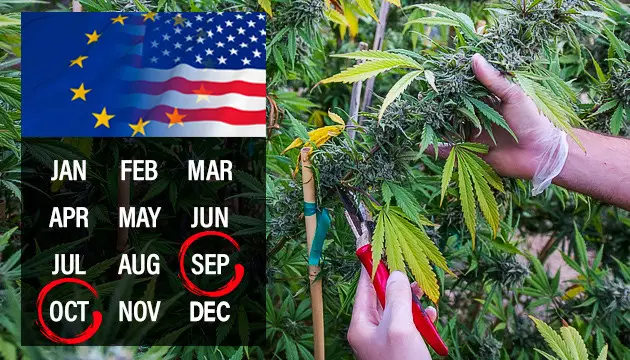
Typically, crops are ready for harvest beginning sometime around September or October. However, this is almost entirely dependent upon the estimated flowering time and specific characteristics of your chosen cannabis strain.
Closely monitor the plants’ trichome and pistil formations for a better idea of appropriate harvesting times. Most plants are ready once most of their pistils transform from white to a reddish-brown color. The trichomes should also be white at this stage, though many cultivators choose to wait until an amber coloration is achieved. To learn more about harvesting by trichomes, read our full article.
Alternative Outdoor Grow Methods
Outdoor cultivators commonly choose to plant either in pots or directly into the earth. However, other growers prefer to grow cannabis in a greenhouse or apply an alternative technique commonly referred to as guerilla growing.
Guerilla Growing Technique

The guerilla method entails growing your cannabis crops outdoors in a hidden or otherwise discreet location that won’t easily be discovered, like a forest or a field with an abundance of other plants. The most obvious advantage to this technique is that your plants will be located a suitable distance away from your home or primary place of residence. Growing away from your home also leaves your plants vulnerable to potential discovery or at risk of taking damage from various outdoor elements.
Disclaimer: Cannabis cultivation laws vary by region. This information is intended for use only in areas where growing cannabis is legal. Please check your local laws before proceeding. Consult your medical adviser before use.
Greenhouse Grow Environments
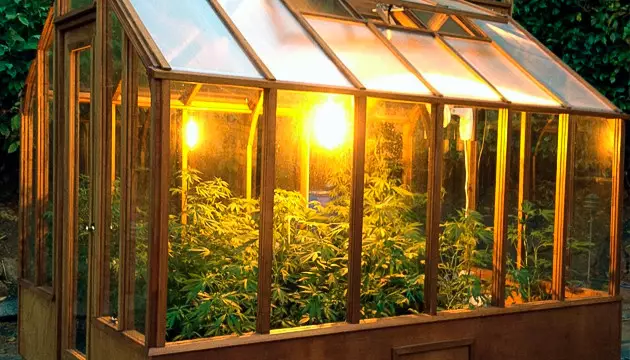
Choosing to cultivate your cannabis crops in a greenhouse environment provides a host of added benefits compared to traditional outdoor cultivation practices such as climate, light, and water control, as well as protection from outside elements. These factors significantly contribute to the development of a healthy cannabis plant that will reward you with maximum yields come harvest time. However, choosing to grow in a greenhouse does have several potential drawbacks that must first be considered:
- Greenhouses are costly to build
- They also require an ample and open outdoor space
- Automated greenhouses consume high amounts of energy
- They’re not safe for cultivators with heat-sensitive medical conditions
A Couple More Tips And Tricks For Growing Weed Outdoors
We’ve covered all the major points of growing marijuana outdoors, but we still have a couple of our favorite outdoor cannabis growing tips and tricks to share:
- If you’re growing in a naturally hot area, invest in shade fabric – this will save your weed from heat stress when temperatures go above 30C (86F).
- Plastic flowers are great for camouflaging cannabis – toss a couple of them on the bush to disguise it as a flowering plant.
- When your outdoor cannabis is harvested, don’t throw away the stalks, leaves, and roots – they can be used to make teas, ointments, and more.
FAQ
When growing weed plants outdoors, do ladybugs can harm them?
No, ladybugs are actually helpful to your cannabis. They are natural predators and can rid your plantation of such pests as root aphids.
Can a helicopter see if you’re growing outdoor weed?
Cannabis has a distinctive shade of green that’s visible from the sky. Grow ops also become more obvious if the plants are grown in even rows of pots. However, hobby growers very rarely get caught because of being noticed via helicopter.
How strongly does weed smell when growing outdoors?
Weed is a naturally fragrant plant, and even though the outdoors does diffuse the smell quite a bit, it will likely still be noticeable. If it’s an issue, we recommend choosing low-odor strains.
What are the chances of growing weed outdoors if you throw seeds outside?
There’s quite a big chance that when a seed encounters suitable germination conditions, like warm weather and moist soil, it will pop and start growing. However, cannabis requires quite a lot of care, so even if it germinates, that doesn’t mean it will successfully grow up until harvest.
Should I trim big fan leaves from cannabis when growing outdoors?
Trimming is a valuable technique that can significantly increase yields when done properly. It’s especially effective in outdoor grows, where cannabis plants thrive with the right care. Check out our article on trimming to learn how to do it correctly and which strains benefit most from it.
When growing cannabis outdoors, do my plants need direct natural sunlight during flowering?
Yes, cannabis enjoys direct sunlight in both the vegetative and flowering stages. Direct sunlight on buds equals increased density and overall quality.
How can I make my weed grow faster outdoors?
The best way to make weed grow faster is to pick quicker strains. Pruning can also help your plants focus their energy on bud development. And of course, cannabis plants that are well-nourished and taken care of always finish on time and don’t take too long.
Disclaimer: Before purchasing and growing cannabis seeds, make sure that cannabis cultivation is legal in your region.
Herbies Head Shop expressly refuses to support the use, production, or supply of illegal substances. For more details read our Legal Disclaimer.


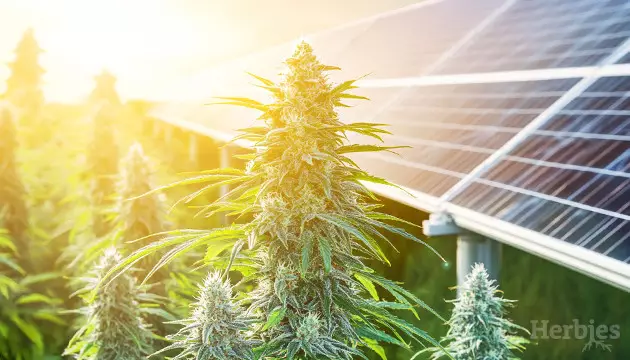







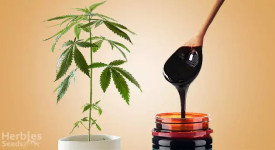
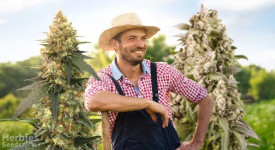
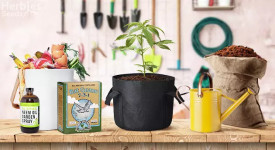


Thank you for leaving a comment for us!
Your feedback will be posted shortly after our moderator checks it.
Please note that we don’t publish reviews that: